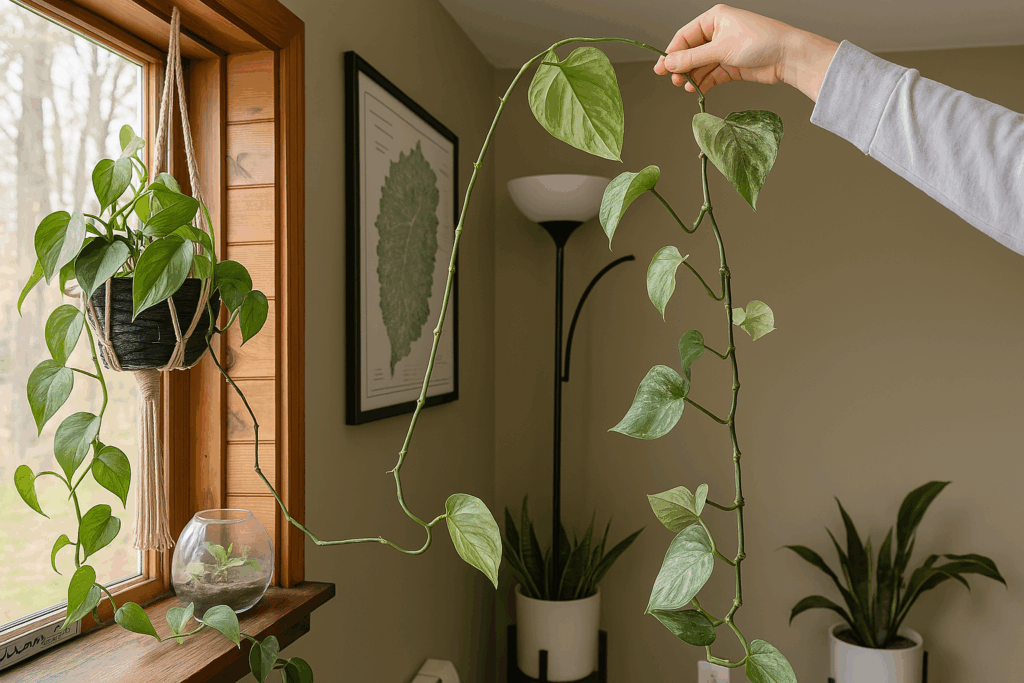Your beloved pothos plant looks like it’s been through a war zone, with bare stems where lush leaves once flourished. As a plant parent, you’ve probably noticed those brown nodes and increasingly sparse foliage, wondering what’s causing this mysterious leaf loss. According to botanist Dr. Sarah Chen, “Missing leaves often signal deeper issues with care routines.” Let’s uncover the common culprits and get your pothos back to its trailing glory.

Contents
Common Signs of Leaf Loss in Pothos Plants
A healthy pothos plant should have lush vines covered in heart-shaped leaves, so bare spots can signal underlying problems. When examining leaf drop on your pothos, look for these key indicators:
- Brown nodes where leaves once grew
- Long stretches of bare vine between remaining leaves
- Yellowing or drooping leaves before they fall
- Thin, spindly growth reaching toward light sources
“Sudden leaf loss often indicates environmental stress affecting overall vine health,” explains botanist Dr. Sarah Chen. Check your plant’s light exposure, watering routine, and soil moisture levels to identify the root cause of missing foliage.

Light Requirements and Growth Patterns
Poor light conditions often cause those bare spots you’ve noticed on your pothos vines. When your plant doesn’t receive enough light, it stretches toward the nearest light source, creating leggy growth with long gaps between leaves.
To fix this issue, adjust your lighting techniques by moving your pothos closer to a window that receives bright, indirect light for 4-8 hours daily. For growth stimulation, you can supplement with LED grow lights if natural light is limited. “Proper lighting is essential for maintaining compact, bushy growth patterns,” says botanist Dr. Sarah Chen. Remember that those brown nubs along bare vines are nodes where leaves once grew.
Proper Watering Techniques and Root Health
While lighting plays an essential role in pothos health, proper watering can make or break your plant’s ability to maintain leaves. Checking soil moisture before watering is vital – insert your finger 1-2 inches deep and only water when the top layer feels dry.
To guarantee ideal drainage solutions:
- Use pots with drainage holes
- Place a catch tray underneath
- Allow excess water to drain completely
- Never let roots sit in standing water
“Root rot from overwatering is the leading cause of leaf drop in pothos plants,” says botanist Dr. Sarah Chen. “Check your soil moisture levels weekly and adjust watering accordingly.”
Essential Nutrients and Feeding Guidelines
Even healthy pothos plants need regular nutrient replenishment to maintain lush foliage and prevent leaf loss. Common nutrient sources include liquid fish emulsion, seaweed extract, or balanced houseplant fertilizers.
“A monthly feeding schedule during the growing season provides ideal results,” explains botanist Dr. Sarah Chen. Here’s what you’ll need:
- Balanced liquid fertilizer (10-10-10)
- Clean water for dilution
- Measuring spoon
Apply these fertilization methods:
- Dilute fertilizer to half-strength
- Feed once monthly from spring through fall
- Skip fertilizing during winter dormancy
- Water thoroughly before applying nutrients
Identifying and Treating Pest Problems
Since pest problems on pothos plants can quickly escalate from a minor nuisance to severe leaf loss, it’s crucial to identify and address infestations early. “The most common culprits are mealybugs, spider mites, and scale insects – all of which leave distinct calling cards,” notes entomologist Dr. Sarah Chen.
Look for these key pest identification techniques:
- White, cotton-like clusters (mealybugs)
- Tiny webs between leaves (spider mites)
- Brown bumps on stems (scale)
For effective pest control methods:
- Wipe leaves with rubbing alcohol
- Spray with insecticidal soap
- Increase humidity to deter spider mites
- Isolate affected plants immediately
